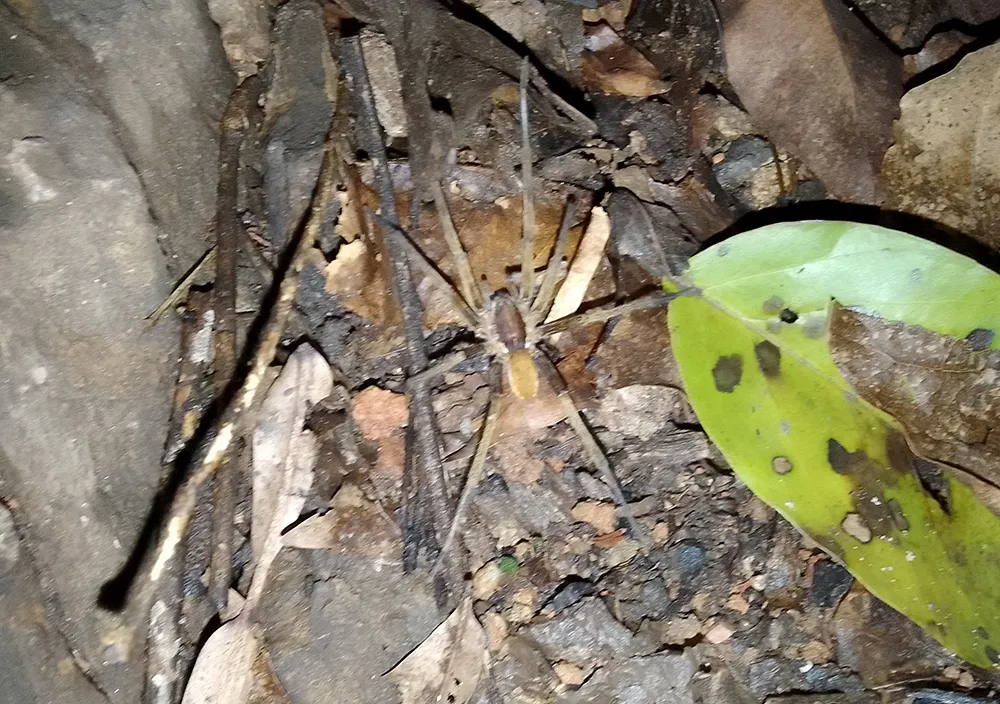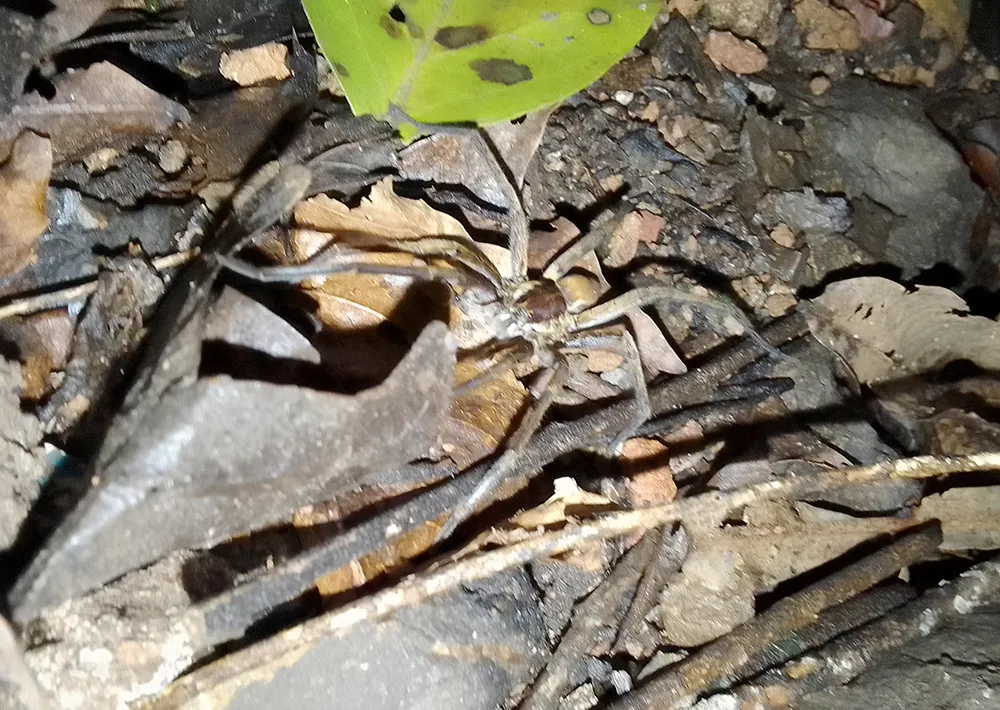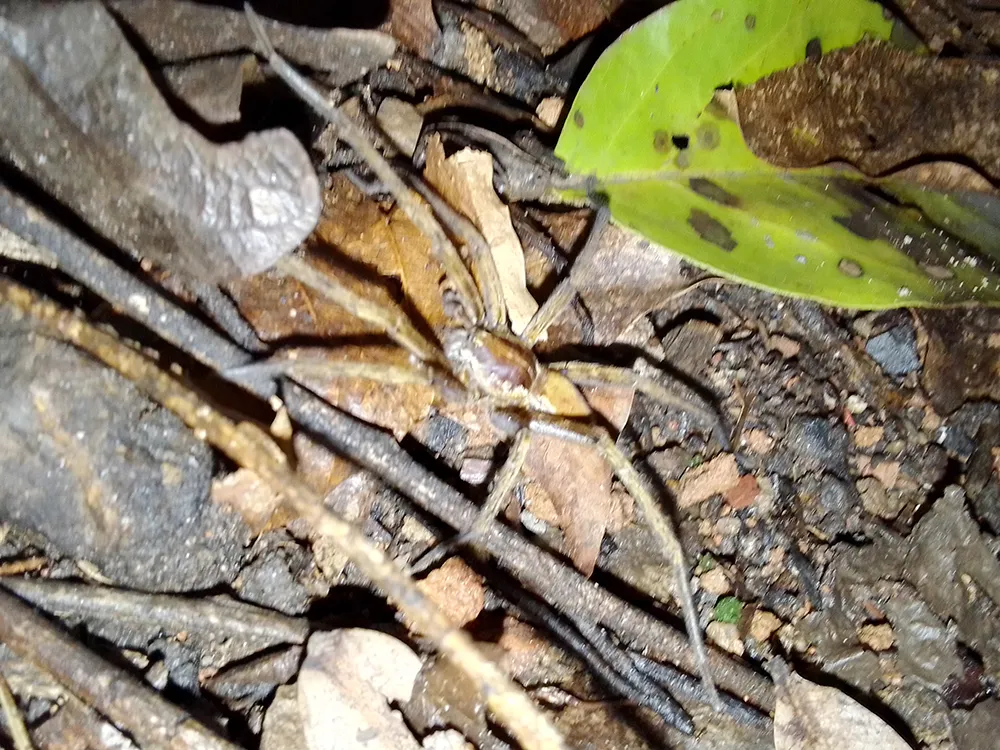As I was walking, at night, along the sidewalk of an avenue adjacent to the foot of a mountain, I saw the movement of an animal that moved quickly towards the mountain. I immediately grabbed my phone, turned on the flashlight, and searched the site.
Mientras caminaba, de noche, por la acera de una avenida colindante con el pie de una montaña, vi el movimiento de un animal que se desplazó rápidamente hacia la montaña. Inmediatamente agarré mi teléfono, le encendí la linterna, y busqué por el sitio.
I found the animal and noticed it was a spider. With the phone I captured some photographs and several short videos that I then compiled into one.
Encontré al animal y noté que era una araña. Con el teléfono le capturé algunas fotografías y varios videos cortos que luego compilé en uno solo.
It is a spider of the family Ctenidae, a family that includes nocturnal hunting spiders that are considered ambush predators because they wait until their prey is close enough to capture, especially at the edges of bodies of water.
Es una araña de la familia Ctenidae, familia que incluye arañas cazadoras nocturnas y que se consideran como depredadoras de emboscada porque esperan a que su presa esté lo suficientemente cerca para capturarla, especialmente en los bordes de masas o cuerpos de agua.

Specifically, it is a spider of the genus Ancylometes and most likely the species Ancylometes bogotensis, a spider that is geographically distributed from Central America to the north and west of South America, in neotropical forests.
Específicamente, es una araña del género Ancylometes y muy probablemnte la especie Ancylometes bogotensis, araña que se distribuye geográficamente desde Centroamérica hasta el norte y oeste de Sudamérica, en los bosques neotropicales.
Morphologically, males of the species Ancylometes bogotensis are characterized by a brown prosoma with white lateral bands, and the opisthosoma and legs show a yellowish brown coloration. In the case of females, the whole body is light brown and uniform, and the femurs are brown although of variable coloration. However, it should be noted that variations may exist, for example, males have been found to be somewhat lighter brown with broad yellow lateral bands on the prosoma, and females with a dark reddish brown prosoma and a light brown opisthosoma. I clarify, for better understanding, that the prosoma could be assumed as the head and thorax united and the opisthosoma as the abdomen.
Morfológicamente, los machos de la especie Ancylometes bogotensis se caracterizan porque el prosoma es de color marrón con bandas blancas laterales, y el opistosoma y patas muestran una coloración marrón amarillenta. En el caso de las hembras, todo el cuerpo es de color marrón claro y uniforme, y los fémures son marrones aunque de coloración variable. No obstante, es de hacer notar que pueden existir variaciones, por ejemplo, se han encontrado machos de color marrón algo más claro con anchas bandas amarillas laterales en el prosoma, y hembras con prosoma de color marrón rojizo oscuro y opistosoma de color marrón claro. Aclaro, para mejor entendimiento, que al prosoma se le podría asumir como la cabeza y el tórax unidos y al opistosoma como el abdomen.
In relation to the courtship and mating of these spiders, it has been documented that near a female, silk draglines can be found to which the male responds by producing rapid vibrations of small amplitude with his first pair of legs in the direction of the female, accompanied by a small slow upward and downward movement of his palps. If the female is not receptive, she quickly lunges at the male, chases him, and if she catches him, kills him. If the female is receptive, she adopts a passive posture, drawing her legs close to her body. The male advances head to head, with the front legs vibrating, and climbs over her. He immediately begins to spin silk threads between the distal ends of the front tibiae, and then turns around to attach similar threads between the second and third pairs of the female's legs. Once the male completes what looks like an “outer ring” of threads, he lays more threads between the patellae, first anteriorly and then posteriorly, to form an “inner ring”. This whole process can take between 15 and 20 minutes, after which the male turns the female trussed on one side to mate her by making several insertions and the mating can last between 10 and 15 minutes and between insertions the male rests. Once mating is complete, the male rapidly runs away and the female slowly frees herself from her bonds. The female may spend 2 to 3 hours cleaning silk from her legs.
Con relación al cortejo y apareamiento de estas arañas, se ha documentado que cerca de una hembra se pueden encontrar líneas de arrastre de seda a las que el macho responde produciendo rápidas vibraciones de pequeña amplitud con su primer par de patas en dirección hacia la hembra, acompañadas de un pequeño movimiento lento de sus palpos hacia arriba y hacia abajo. Si la hembra no está receptiva, se abalanza rápidamente sobre el macho, lo persigue, y si lo atrapa lo mata. Si la hembra está receptiva, adopta una postura pasiva, acercando las patas al cuerpo. El macho avanza cabeza con cabeza, con las patas delanteras vibrando, y trepa sobre ella. Inmediatamente empieza a tejer hilos de seda entre los extremos distales de las tibias delanteras, y posteriormente da la vuelta para colocar hilos similares entre el segundo y el tercer par de patas de la hembra. Una vez que el macho completa, lo que parece un "anillo exterior" de hilos, coloca más hilos entre las rótulas, primero en sentido anterior y luego posterior, para formar un "anillo interior". Todo este proceso puede tardar entre 15 y 20 minutos, después de los cuales el macho gira a la hembra atada sobre un lado para aparearla realizando varias inserciones y el apareamiento puede durar entre 10 y 15 minutos y entre inserciones el macho descansa. Una vez finalizado el apareamiento, el macho huye rápidamente y la hembra se libera lentamente de sus ataduras. La hembra puede pasar de 2 a 3 horas limpiando la seda de sus patas.

Other aspects of the reproductive biology of Ancylometes bogotensis are, that the females build an egg sac, which is a flattened disk about 15 to 18 millimeters in diameter with a convex upper surface of hard, thick, purplish-brown silk, and a flat or slightly hollowed, softer, paler under surface of thin silk, through which the eggs can be seen. The mother carries them in her palps and chelicerae until shortly before the young emerge, and then deposits the sac in the middle of a large irregular web that she spins among branches. It should be noted that, an egg sac may contain between 300 and 400 eggs, although one spider has also been reported carrying an egg sac containing approximately 600 eggs.
Otros aspectos de la biología reproductiva de Ancylometes bogotensis son, que las hembras construyen un saco de huevos, que es un disco aplanado de unos 15 a 18 milímetros de diámetro con una superficie superior convexa de seda dura, gruesa y de color marrón violácea, y una superficie inferior plana o ligeramente ahuecada, más blanda y pálida, de seda fina, a través de la cual se pueden ver los huevos. La madre los transporta en sus palpos y quelíceros hasta poco antes de la salida de los jóvenes, y luego deposita el saco en medio de una gran telaraña irregular que teje entre ramas. Cabe destacar que, un saco de huevos puede contener entre 300 y 400 huevos, aunque también se ha informado de una araña que llevaba un saco de huevos que contenía aproximadamente 600 huevos.
On the other hand, as I suggested above, Ancylometes bogotensis is a hunting spider in moist neotropical forests, but it can also be found in riverine vegetation, in floating meadows composed of semi-aquatic and aquatic macrophyte plants, and in black- and whitewater inundation forests. In general, they live mostly on the ground, where they hide during the day in natural crevices and hunt ambushing at night.
Por otro lado, como indiqué sugiriendo anteriormente, Ancylometes bogotensis es una araña cazadora en los bosques neotropicales húmedos, pero también se le puede encontrar en la vegetación ribereña de los ríos, en praderas flotantes compuestas de plantas macrófitas semiacuáticas y acuáticas, y en bosques de inundación de aguas blancas y negras. En general, viven principalmente en el suelo, donde se esconden durante el día en grietas naturales y cazan emboscando por la noche.

Similar to other species of the genus Ancylometes, which show a varied diet that ranges from insects to small vertebrates such as fish, tadpoles, frogs, toads and lizards, the species Ancylometes bogotensis has been seen preying on a toad of the species Elachistocleis panamensis on the leaf of a shrub located approximately 40 centimeters from the ground and near a stream located approximately 2 meters from the shrub. In the predation event it was observed that the spider held the toad with the chelicerae sunk in its lower abdominal region and with the the aid of the pedipalps, and also, that the toad did not attempt to free itself from the spider because it was paralyzed.
Al igual, que otras especies del género Ancylometes, las cuales muestran una dieta variada que va desde insectos a pequeños vertebrados como peces, renacuajos, ranas, sapos y lagartijas, a la especie Ancylometes bogotensis se le ha visto depredando a un sapo de la especie Elachistocleis panamensis en la hoja de un arbusto ubicada aproximadamente a 40 centímetros del suelo y cerca de un arroyo ubicado aproximadamente a 2 metros del arbusto. En el evento de depredación se observó que la araña sujetaba al sapo con los quelíceros hundidos en su región baja abdominal y con ayuda de los pedipalpos, y también, que el sapo no intentó liberarse de la araña porque quedó paralizado.
Another toad of the species Rhinella beebei has also been observed being preyed upon by a spider Ancylometes bogotensis on the edge of a grassy ditch, which bordered a narrow road surrounded by abandoned sugar cane fields. The ditch was full of grass and had standing water because it had rained. The toad was still breathing, although it was motionless, and the spider's chelicerae were moving slightly in a tentative motion, suggesting that the spider was waiting for the enzymatic action to be triggered. In this case, the toad was larger but the spider was able to move it effectively.
Otro sapo de la especie Rhinella beebei también ha sido observado siendo presa de una araña Ancylometes bogotensis en el borde de una zanja cubierta de hierba, que bordeaba una estrecha carretera rodeada de campos de caña de azúcar abandonados. La zanja estaba llena de hierba y tenía agua estancada porque había llovido. El sapo seguía respirando, aunque estaba inmóvil, y los quelíceros la araña los movía ligeramente tanteando al sapo, lo que hizo suponer que la araña estaba esperando a que se desencadenara la acción enzimática. En este caso, el sapo era más grande pero la araña fue capaz de moverlo con eficacia.

In another predation event that occurred in a pool on the bank of a stream, a spider of the species Ancylometes bogotensis was observed capturing a fish of the species Rivulus hartii (or Anablepsoides hartii). The spider stood with three of its legs on floating vegetation and five on the water of the pool while holding with its chelicerae the fish that was submerged in the water. Subsequently, the spider climbed up to the bank of the pool and remained there, completely still, with the fish motionless. It should be noted that the fish measured 8 centimeters and the spider, with its legs extended, 12 centimeters, and its prosoma 3.5 centimeters long and 1.5 centimeters wide.
En otro evento de depredación ocurrido en una charca en la orilla de un arroyo, fue observada una araña de la especie Ancylometes bogotensis que había capturado a un pez de la especie Rivulus hartii (o Anablepsoides hartii). La araña se mantenía con tres de sus patas sobre vegetación flotante y cinco sobre el agua de la charca mientras sostenía con sus quelíceros al pez que se encontraba sumergido en el agua. Posteriormente la araña subió a la orilla de la charca y permaneció allí, completamente quieta, con el pez inmóvil. Cabe destacar que el pez medía 8 centímetros y la araña, con las patas extendidas 12 centímetros, y su prosoma 3,5 centímetros de largo y 1,5 centímetros de ancho.
The above event gives the opportunity to comment that the spider Ancylometes bogotensis has the ability to move on the surface of the water and remain submerged for long periods, because it has a layer of fine hairs that trap air bubbles around its body. These hairs also serve to detect disturbances in the water and alert the spider to the presence of prey. It has even been observed that these spiders, when hunting frogs and tadpoles, can hide for up to 20 minutes underwater when disturbed. In general, the spider can be found on the banks or on aquatic vegetation, ready to attack when the water surface is disturbed by prey.
El evento anterior da la oportunidad para comentar que, la araña Ancylometes bogotensis tiene la capacidad de moverse por la superficie del agua y permanecer sumergida durante largos periodos, esto debido a que posee capa de finos pelos que atrapan burbujas de aire alrededor de su cuerpo. Estos pelos también sirven para detectar perturbaciones en el agua y alertar a la araña de la presencia de presas. Incluso, se ha observado que estas arañas cuando cazan ranas y renacuajos, pueden esconderse hasta 20 minutos bajo el agua cuando se les molesta. En general, a la araña se le puede encontrar en las orillas o sobre la vegetación acuática, lista para atacar cuando se perturba la superficie del agua por causa de alguna presa.

Finally, to comment on an event in which three adult Ancylometes bogotensis spiders were observed feeding on an adult freshwater crab of the species Dilocarcinus dentatus. The spiders were on vegetation along a flooded trail and there were many crabs in the water. The crab was initially held by a female spider; two males were then seen that approached and also fed on the crab. Although the capture of the crab was not observed, it is likely that the female spider captured the crab alive and carried it into the surrounding vegetation to feed on it, as only species of the genus Ancylometes are known to feed on prey that they have captured themselves. Interestingly, despite being in close proximity to each other, no aggressive behavior was observed among the three spiders.
Finalmente, comentar sobre un evento en el que se observaron a tres arañas adultas de Ancylometes bogotensis alimentándose de un cangrejo de agua dulce adulto de la especie Dilocarcinus dentatus. Las arañas estaban sobre la vegetación a lo largo de un sendero inundado y había muchos cangrejos en el agua. El cangrejo lo sujetaba inicialmente una araña hembra; luego se vio a dos machos que se acercaron y también se alimentaron del cangrejo. Aunque no se observó la captura del cangrejo, es probable que la araña hembra lo capturara vivo y lo llevara a la vegetación circundante para alimentarse de él, ya que solo se sabe que las especies del género Ancylometes se alimentan de presas que han capturado ellos mismos. Algo interesante en el evento fue, que a pesar de estar cerca unas de otras, no se observó ningún comportamiento agresivo entre las tres arañas.
Below is the compiled video of the spider.
A continuación, el video compilado de la araña.

Fotografías y video capturados con teléfono TECNO POP 7 (BF6).
